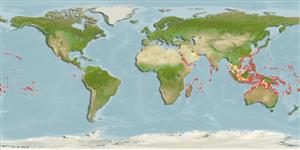Actinopterygii (ray-finned fishes) >
Perciformes (Perch-likes) >
Labridae (Wrasses) > Corinae
Etymology: Hologymnosus: Greek, holos = full + Greek, gymnos = naked (Ref. 45335).
Environment / Climate / Range
Ecology
Marine; reef-associated; depth range 8 - 40 m (Ref. 90102). Tropical; 25°C - 28°C (Ref. 27115), preferred ?; 32°N - 28°S
Indo-Pacific: Red Sea and South Africa (Ref. 11228) to the Society and Pitcairn islands, north to southern Japan, south to southeastern Australia and Rapa Island.
Size / Weight / Age
Maturity: Lm ? range ? - ? cm
Max length : 40.0 cm TL male/unsexed; (Ref. 2334); common length : 34.0 cm TL male/unsexed; (Ref. 5450)
Dorsal
spines
(total): 9;
Dorsal
soft rays
(total): 12;
Anal
spines: 3;
Anal
soft rays: 12. Two-color forms: the 'true' species in the Indian Ocean and Red Sea and its sibling in the Pacific regions. Females look almost black; males mainly greenish with blue face, of which Indian form shows a white band central to the body, whilst the Pacific form a pale peduncular area when in nuptial mode (Ref. 48636). Juvenile H. annulatus very closely resemble juvenile Malacanthus latovittatus (Ref.1602). Poorly developed pharyngeal teeth (Ref. 1602).
Found on coral reefs and rocky substrates to depths of at least 30 m (Ref. 9823) on offshore reef slopes (Ref. 90102). Juveniles generally solitary (Ref. 9710). Feeds primarily on small fishes, also on crustaceans (Ref. 2334).
Life cycle and mating behavior
Maturity | Reproduction | Spawning | Eggs | Fecundity | Larvae
Pelagic spawner.
Randall, J.E., G.R. Allen and R.C. Steene, 1990. Fishes of the Great Barrier Reef and Coral Sea. University of Hawaii Press, Honolulu, Hawaii. 506 p. (Ref. 2334)
IUCN Red List Status (Ref. 115185)
CITES (Ref. 94142)
Not Evaluated
Threat to humans
Harmless
Human uses
Fisheries: minor commercial; aquarium: commercial
More information
ReferencesAquacultureAquaculture profileStrainsGeneticsAllele frequenciesHeritabilityDiseasesProcessingMass conversion
Tools
Special reports
Download XML
Internet sources
